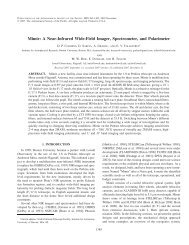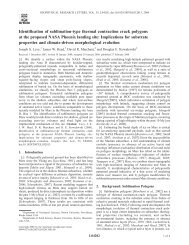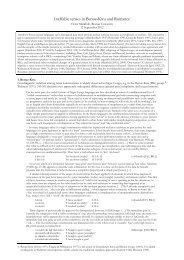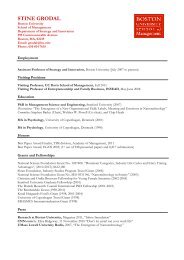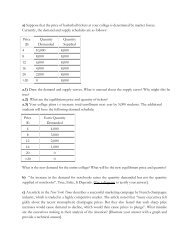Axiom B6 (Dynamic Consistency) For all t <strong>and</strong> s t , for all c ∈ C <strong>and</strong> h, h ′ ∈ H, if h(s)(strictly) stochastically dominates h ′ (s) with regard to ≽ s t ,s for each s ∈ S, then(c, δ[h]) ≽ s t (≻ s t) (c, δ[h ′ ]).Finally, we embed Seo’s (2009) dominance axiom to the set of one-step-ahead acts. Aone-step-ahead act is an act for which subjective uncertainty resolves just in one period. Wedefine the set of one-step-ahead acts as:H +1 = {h +1 ∈ H : h +1 (s) ∈ L, ∀s ∈ S}.Definition 6 Given h +1 ∈ H +1 <strong>and</strong> π ∈ ∆ (S), define l(h +1 , π) ∈ L by:l(h +1 , π) = ∑ s∈Sh +1 (s)π(s).Given p +1 ∈ ∆(H +1 ) <strong>and</strong> π ∈ ∆(S), define a(p +1 , π) ∈ ∆(L) by:for every Borel subset L ⊂ L.a(p +1 , π)(L) = p +1 ({h +1 ∈ H +1 : l(h +1 , π) ∈ L}) ,We take a set of one-step-ahead probability measures, P s t, as given for each history s t<strong>and</strong> impose the following Dominance axiom on this set. We allow this set to be differentfrom ∆ (S) in order to permit more flexibility in applications as discussed in Section 1.Axiom B7 (Dominance) For all t <strong>and</strong> s t , for all c ∈ C <strong>and</strong> p +1 , p ′ +1 ∈ ∆(H +1 ),(c, a(p +1 , π)) ≽ s t (c, a(p ′ +1, π)), ∀π ∈ P s t =⇒ (c, p +1 ) ≽ s t (c, p ′ +1),where P s t ⊂ ∆ (S) .To interpret this axiom, imagine that P s t is a set of probability distributions, whichcontains the ‘true’ distribution unknown to the decision maker. Given the same currentconsumption c, if the decision maker prefers the continuation two-stage lottery a(p +1 , π)induced by p +1 over another one a(p ′ +1, π) induced by p ′ +1 for each probability distributionπ ∈ P s t, then he must also prefer (c, p +1 ) over ( c, p +1) ′ .Compared to the axioms in Section 3, First-Stage Independence <strong>and</strong> Dominance arethe counterparts of the SEU on Second-Order Acts <strong>and</strong> Consistency with Preference overSecond-Order Acts. Thus, we can dispense with second-order acts.21
4.3. RepresentationThe following theorem gives our second representation result.Theorem 4 (Representation) The preference process {≽ s t} satisfies Axioms B1-B7 if <strong>and</strong>only if there exists a family of functions ({V s t}, W, u, v) <strong>and</strong> a process of probability measures{µ s t} over P s t, such that for each s t , the function V s t : C × ∆(H) → R represents ≽ s t<strong>and</strong>has the form: V s t(c, p) =( ( ∫ ∫ ( ∑W c, v −1 v ◦ u −1H P s ts∈S∫)))π(s) u(V s t ,s(c ′ , a ′ ))dh(s)(c ′ , a ′ ) dµ s t(π)dp(h) ,C×∆(H)(17)for (c, p) ∈ C ×∆(H), where W is continuous <strong>and</strong> strictly increasing in the second argument,u <strong>and</strong> v are continuous <strong>and</strong> strictly increasing.We also have the following uniqueness result, up to some monotonic affine transformations:Theorem 5 (Uniqueness) Let {≽ s t} satisfy Axioms B1-B7. If both ({Ṽs t}, ˜W , ũ, ṽ, {˜µ s t})<strong>and</strong> ({V s t}, W, u, v, {µ s t}) represent {≽ s t}, then there exist a strictly increasing function Φ<strong>and</strong> constants A, B, D, E with A, D > 0, such that:Ṽ s t = Φ ◦ V s t, ˜W (·, ·) = Φ(W (·, Φ −1 (·))),ũ ◦ Φ = Au + B, ṽ ◦ Φ = Dv + E.As in the static model of Seo (2009), the process of second-order beliefs {µ s t} is not uniquein general. For example, when φ = v ◦ u −1 is linear, {µ s t} is indeterminate. It is unique if φis some exponential function. The existence of a solution for {V s t} to the recursive equation(17) follows a similar argument in the proof of Theorem 2 in KMM (2009a). We may applysufficient conditions in Marinacci <strong>and</strong> Montrucchio (2009) to establish uniqueness. The listbelow shows how the above model nests the existing models:1. On the subdomain C × G, the representation reduces to (11), which further reduces to(2) on C × F.2. On the subdomain C × ∆(L), we obtain a pure risk setting where the two-stage r<strong>and</strong>omizationis present. In this case, each V s t coincides with the common representation:(∫ (∫) ))V (c, a) = W(c, v −1 v ◦ u −1 u(V (c ′ , a ′ ))dl(c ′ , a ′ ) da(l) , (18)LC×∆(L)where (c, a) ∈ C × ∆(L).22
- Page 1: Intertemporal Substitution andRecur
- Page 6 and 7: As in KMM (2005, 2009a), we impose
- Page 8 and 9: 2. Review of the Atemporal ModelsIn
- Page 10 and 11: defined over it. Notice that by res
- Page 12: For any c ∈ C, we use δ[c] to de
- Page 15: The axiom below states that the pre
- Page 18: is ambiguity averse if he prefers a
- Page 24 and 25: 3. On the subdomain C × M, we obta
- Page 26 and 27: We can similarly define ambiguity l
- Page 28 and 29: epresentations under these two appr
- Page 30 and 31: where R t+1 is the market return fr
- Page 32 and 33: Segal (1987, 1990) and Seo (2009).
- Page 34 and 35: A Appendix: Proof of Theorems 1 and
- Page 36 and 37: Define v = ψ ◦ ū −1 ◦ u, wh
- Page 38 and 39: compute:∫˜ū (m) =∫=∫=∫= A
- Page 40 and 41: DefineH = {h = (h 0 , h 1 , h 2 ,
- Page 42 and 43: Lemma 5 We have the homeomorphic re
- Page 44 and 45: Finite-step-ahead acts and densenes
- Page 46 and 47: which is strictly increasing in the
- Page 48 and 49: where the second equality follows f
- Page 50 and 51: D Appendix: Proofs for Section 4.4P
- Page 52 and 53: This relation holds true because i
- Page 54 and 55: In complete markets, the following
- Page 56 and 57: Ergin, H. I. and F. Gul (2009): “
- Page 58: Weil, P. (1989): “The Equity Prem



